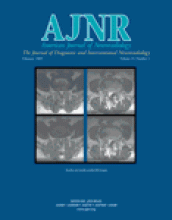Abstract
BACKGROUND AND PURPOSE: Oxygen has a known paramagnetic effect and increases CSF signal intensity on fluid-attenuated inversion recovery (FLAIR) MR images. The purposes of this study were to investigate the effect of supplemental oxygen on CSF signal intensity and the arterial partial pressure of oxygen and to determine the possible synergistic effect of oxygen and albumin on T1 shortening effect in vitro.
METHODS: Six healthy volunteers underwent FLAIR MR imaging of the brain before and during inhalation of 10 to 15 L/min of 100% oxygen for ≤30 min. The signal intensity was measured in the subarachnoid spaces and various tissues and correlated with estimated arterial partial pressure of oxygen and arterial carbon dioxide pressure. In vitro measurements were also obtained by using two sets of saline-filled tubes with various concentrations of albumin, one of which was exposed to increased oxygen levels. In vitro T1 relaxation times were calculated to assess the possible synergistic effect of oxygen and albumin.
RESULTS: FLAIR images of healthy volunteers showed increased CSF signal intensity within the basal cisterns and sulci along the cerebral convexities. The CSF hyperintensity was observed immediately after the initiation of supplemental oxygen and remained stable during the oxygen administration. There was approximately a 4- to 5.3-fold increase in signal intensity with supplemental oxygen. The phantom experiments showed a T1 shortening effect of oxygen. Albumin significantly altered T1 relaxation time only at high concentrations of albumin.
CONCLUSION: Inhalation of increased levels of oxygen led to readily detectable CSF hyperintensity on FLAIR images of healthy volunteers. No significant synergetic effect of albumin and oxygen was noted.
- Copyright © American Society of Neuroradiology












